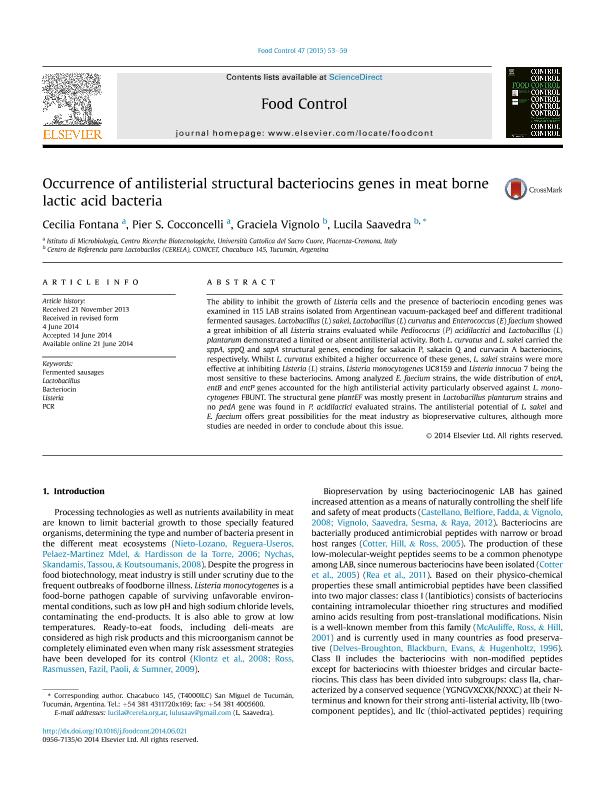Mostrar el registro sencillo del ítem
dc.contributor.author
Fontana, Cecilia Alejandra

dc.contributor.author
Cocconcelli, Pier S.
dc.contributor.author
Vignolo, Graciela Margarita

dc.contributor.author
Saavedra, Maria Lucila

dc.date.available
2020-04-06T20:35:52Z
dc.date.issued
2015-01
dc.identifier.citation
Fontana, Cecilia Alejandra; Cocconcelli, Pier S.; Vignolo, Graciela Margarita; Saavedra, Maria Lucila; Occurrence of antilisterial structural bacteriocins genes in meat borne lactic acid bacteria; Elsevier; Food Control; 47; 1-2015; 53-59
dc.identifier.issn
0956-7135
dc.identifier.uri
http://hdl.handle.net/11336/102096
dc.description.abstract
The ability to inhibit the growth of Listeria cells and the presence of bacteriocin encoding genes was examined in 115 LAB strains isolated from Argentinean vacuum-packaged beef and different traditional fermented sausages. Lactobacillus (L) sakei, Lactobacillus (L) curvatus and Enterococcus (E) faecium showed a great inhibition of all Listeria strains evaluated while Pediococcus (P) acidilactici and Lactobacillus (L) plantarum demonstrated a limited or absent antilisterial activity. Both L. curvatus and L. sakei carried the sppA, sppQ and sapA structural genes, encoding for sakacin P, sakacin Q and curvacin A bacteriocins, respectively. Whilst L. curvatus exhibited a higher occurrence of these genes, L. sakei strains were more effective at inhibiting Listeria (L) strains, Listeria monocytogenes UC8159 and Listeria innocua 7 being the most sensitive to these bacteriocins. Among analyzed E. faecium strains, the wide distribution of entA, entB and entP genes accounted for the high antilisterial activity particularly observed against L. monocytogenes FBUNT. The structural gene plantEF was mostly present in Lactobacillus plantarum strains and no pedA gene was found in P. acidilactici evaluated strains. The antilisterial potential of L. sakei and E. faecium offers great possibilities for the meat industry as biopreservative cultures, although more studies are needed in order to conclude about this issue.
dc.format
application/pdf
dc.language.iso
eng
dc.publisher
Elsevier

dc.rights
info:eu-repo/semantics/openAccess
dc.rights.uri
https://creativecommons.org/licenses/by-nc-sa/2.5/ar/
dc.subject
LACTIC ACID BACTERIA
dc.subject
ANTI-LISTERIAL
dc.subject
BACTERIOCIN
dc.subject
L. SAKEI
dc.subject
FERMENTED SAUSAGES
dc.subject
LACTOBACILLUS
dc.subject
LISTERIA
dc.subject
PCR
dc.subject
L. CURVATUS
dc.subject.classification
Biología Celular, Microbiología

dc.subject.classification
Ciencias Biológicas

dc.subject.classification
CIENCIAS NATURALES Y EXACTAS

dc.title
Occurrence of antilisterial structural bacteriocins genes in meat borne lactic acid bacteria
dc.type
info:eu-repo/semantics/article
dc.type
info:ar-repo/semantics/artículo
dc.type
info:eu-repo/semantics/publishedVersion
dc.date.updated
2020-04-02T14:57:46Z
dc.journal.volume
47
dc.journal.pagination
53-59
dc.journal.pais
Países Bajos

dc.journal.ciudad
Amsterdam
dc.description.fil
Fil: Fontana, Cecilia Alejandra. Consejo Nacional de Investigaciones Científicas y Técnicas. Centro Científico Tecnológico Conicet - Tucumán. Centro de Referencia para Lactobacilos; Argentina. Università Cattolica del Sacro Cuore; Italia
dc.description.fil
Fil: Cocconcelli, Pier S.. Università Cattolica del Sacro Cuore; Italia
dc.description.fil
Fil: Vignolo, Graciela Margarita. Consejo Nacional de Investigaciones Científicas y Técnicas. Centro Científico Tecnológico Conicet - Tucumán. Centro de Referencia para Lactobacilos; Argentina
dc.description.fil
Fil: Saavedra, Maria Lucila. Consejo Nacional de Investigaciones Científicas y Técnicas. Centro Científico Tecnológico Conicet - Tucumán. Centro de Referencia para Lactobacilos; Argentina
dc.journal.title
Food Control

dc.relation.alternativeid
info:eu-repo/semantics/altIdentifier/doi/https://doi.org/10.1016/j.foodcont.2014.06.021
dc.relation.alternativeid
info:eu-repo/semantics/altIdentifier/url/https://www.sciencedirect.com/science/article/abs/pii/S0956713514003508
Archivos asociados
